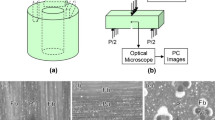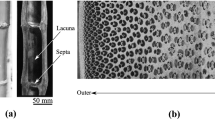Abstract
The stem of the bamboo plant consists of a hollow, tubular culm with periodic nodes, characterised by an internal diaphragm and an external ridge. Bamboo is a highly anisotropic material having a strong fibre orientation, but in the vicinity of the nodes, the fibres diverge from their longitudinal orientations. Previous researchers have claimed that the nodes have a biomechanical function, preventing failure by making the tube stiffer and stronger. To investigate this claim, tensile and bending tests were carried out on material samples and intact culms, both with and without nodes, to investigate culm stiffness and strength. Crack propagation tests were also carried out to determine the effect of nodes on fracture toughness. The results suggest that far from being a point of strength, the node may be a point of weakness when loaded in tension. Material in the node has a significantly lower tensile strength; in bending tests on intact culm lengths, failure occurs when the stress on the tensile side is exactly equal to the node’s tensile strength. Failure occurs by longitudinal splitting: it is proposed that this may be initiated by cracks forming in the nodes. The spacing of nodes is too large to affect the stiffness and strength of the tube as a whole and also greater than the critical crack length for brittle fracture. Thus, the diaphragm and ridge structure of the node can be explained as an attempt to reinforce a biologically essential feature which would otherwise be a point of weakness.







Similar content being viewed by others
References
Amada S, Untao S (2001) Fracture properties of bamboo. Compos Part B Eng 32:451–459
Chung KF, Yu WK (2002) Mechanical properties of structural bamboo for bamboo scaffoldings. Eng Struct 24:429–442
Janssen M, Zuidema J, Wanhill R (2002) Fracture mechanics. Spon Press, London
Kappel R, Mattheck C, Bethge K, Tesari I (2003) Bamboo as a composite structure and its mechanical failure behaviour. In: Collins M, Brebbia CA (eds) Design and nature II: comparing design in nature with science and engineering. WIT Press, Southampton, pp 285–293
Lo TY, Cui HZ, Leung HC (2004) The effect of fiber density on strength capacity of bamboo. Mater Lett 58:2595–2598
Low IM, Che ZY, Latella BA (2006) Mapping the structure, composition and mechanical properties of bamboo. J Mater Res 21:1969–1976
Mitch D, Harries KA, Sharma B (2010) Characterization of splitting behavior of bamboo culms. J Mater Civ Eng 22:1195–1199
Nogata F, Takahashi H (1995) Intelligent functionally graded material: bamboo. Compos Eng 5:743–751
Shao ZP, Fang CH, Tian GL (2009) Mode I interlaminar fracture property of moso bamboo (Phyllostachys pubescens). Wood Sci Technol 43:527–536
Shao ZP, Zhou L, Liu YM, Wu ZM, Arnaud C (2010) Differences in structure and strength between internode and node sections of moso bamboo. J Trop For Sci 22:133–138
Tan T, Rahbar N, Allameh SM, Kwofie S, Dissmore D, Ghavami K, Soboyejo WO (2011) Mechanical properties of functionally graded hierarchical bamboo structures. Acta Biomater 7:3796–3803
Torres LA, Ghavami K, Garcia JJ (2007) A transversely isotropic law for the determination of the circumferential Young’s modulus of bamboo with diametric compression tests. Lat Am Appl Res 37:255–260
Wang F, Shao Z, Wu Y, Wu D (2014) The toughness contribution of bamboo node to the mode I interlaminar fracture toughness of bamboo. Wood Sci Technol 48(6):1257–1268
Wegst UGK, Ashby MF (2007) The structural efficiency of orthotropic stalks, stems and tubes. J Mater Sci 42:9005–9014
Acknowledgments
We are grateful to Martin McNulty of Bamboo Suppliers of Ireland and to Brendan Sayers of the National Botanic Gardens, Glasnevin, Dublin, for supplying bamboo culms and helpful advice.
Author information
Authors and Affiliations
Corresponding author
Rights and permissions
About this article
Cite this article
Taylor, D., Kinane, B., Sweeney, C. et al. The biomechanics of bamboo: investigating the role of the nodes. Wood Sci Technol 49, 345–357 (2015). https://doi.org/10.1007/s00226-014-0694-4
Received:
Published:
Issue Date:
DOI: https://doi.org/10.1007/s00226-014-0694-4




